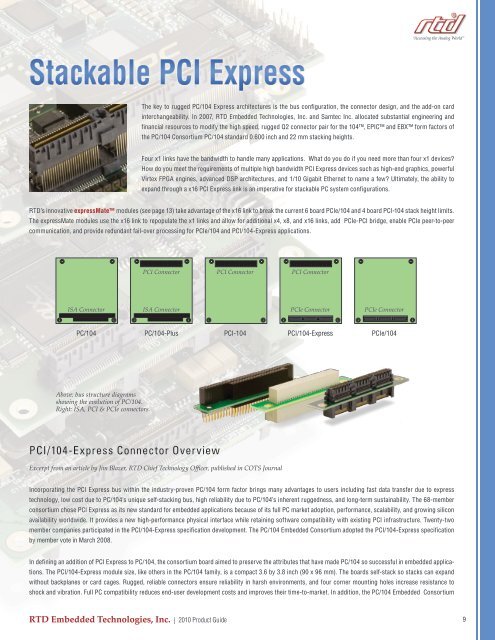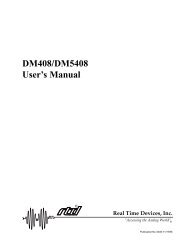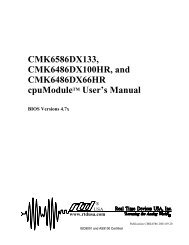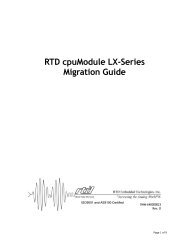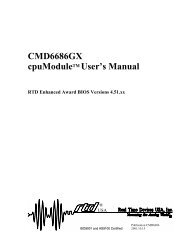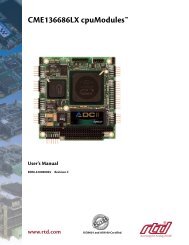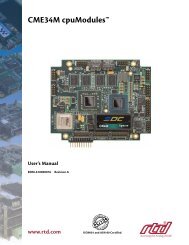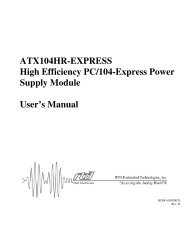RTD/Target Catalog - RTD Embedded Technologies, Inc.
RTD/Target Catalog - RTD Embedded Technologies, Inc.
RTD/Target Catalog - RTD Embedded Technologies, Inc.
You also want an ePaper? Increase the reach of your titles
YUMPU automatically turns print PDFs into web optimized ePapers that Google loves.
“Accessing the Analog World”<br />
The key to rugged PC/104 Express architectures is the bus configuration, the connector design, and the add-on card<br />
interchangeability. In 2007, <strong>RTD</strong> <strong>Embedded</strong> <strong>Technologies</strong>, <strong>Inc</strong>. and Samtec <strong>Inc</strong>. allocated substantial engineering and<br />
financial resources to modify the high speed, rugged Q2 connector pair for the 104, EPIC and EBX form factors of<br />
the PC/104 Consortium PC/104 standard 0.600 inch and 22 mm stacking heights.<br />
Four x1 links have the bandwidth to handle many applications. What do you do if you need more than four x1 devices?<br />
How do you meet the requirements of multiple high bandwidth PCI Express devices such as high-end graphics, powerful<br />
Virtex FPGA engines, advanced DSP architectures, and 1/10 Gigabit Ethernet to name a few? Ultimately, the ability to<br />
expand through a x16 PCI Express link is an imperative for stackable PC system configurations.<br />
<strong>RTD</strong>’s innovative expressMate modules (see page 13) take advantage of the x16 link to break the current 6 board PCIe/104 and 4 board PCI-104 stack height limits.<br />
The expressMate modules use the x16 link to repopulate the x1 links and allow for additional x4, x8, and x16 links, add PCIe-PCI bridge, enable PCIe peer-to-peer<br />
communication, and provide redundant fail-over processing for PCIe/104 and PCI/104-Express applications.<br />
PCI Connector PCI Connector PCI Connector<br />
ISA Connector ISA Connector PCIe Connector<br />
PCIe Connector<br />
PC/104 PC/104-Plus PCI-104 PCI/104-Express PCIe/104<br />
Above: bus structure diagrams<br />
showing the evolution of PC/104.<br />
Right: ISA, PCI & PCIe connectors.<br />
PCI/104-Express Connector Overview<br />
Excerpt from an article by Jim Blazer, <strong>RTD</strong> Chief Technology Officer, published in COTS Journal<br />
<strong>Inc</strong>orporating the PCI Express bus within the industry-proven PC/104 form factor brings many advantages to users including fast data transfer due to express<br />
technology, low cost due to PC/104’s unique self-stacking bus, high reliability due to PC/104’s inherent ruggedness, and long-term sustainability. The 68-member<br />
consortium chose PCI Express as its new standard for embedded applications because of its full PC market adoption, performance, scalability, and growing silicon<br />
availability worldwide. It provides a new high-performance physical interface while retaining software compatibility with existing PCI infrastructure. Twenty-two<br />
member companies participated in the PCI/104-Express specification development. The PC/104 <strong>Embedded</strong> Consortium adopted the PCI/104-Express specification<br />
by member vote in March 2008.<br />
In defining an addition of PCI Express to PC/104, the consortium board aimed to preserve the attributes that have made PC/104 so successful in embedded applications.<br />
The PCI/104-Express module size, like others in the PC/104 family, is a compact 3.6 by 3.8 inch (90 x 96 mm). The boards self-stack so stacks can expand<br />
without backplanes or card cages. Rugged, reliable connectors ensure reliability in harsh environments, and four corner mounting holes increase resistance to<br />
shock and vibration. Full PC compatibility reduces end-user development costs and improves their time-to-market. In addition, the PC/104 <strong>Embedded</strong> Consortium<br />
<strong>RTD</strong> <strong>Embedded</strong> <strong>Technologies</strong>, <strong>Inc</strong>. | 2010 Product Guide 9


